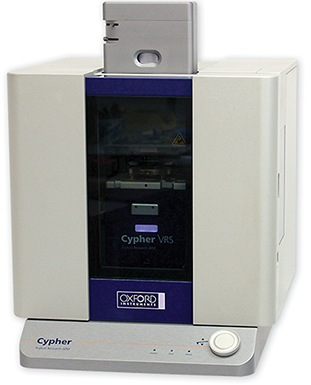AFM Systems
AFM Accessories
Learning
Contact Us
Many of the research groups using the Cypher VRS video-rate AFM and other high-speed AFMs use them to visualize reactions and other dynamics in biomolecular systems. However, many non-biological molecules also exhibit self-assembly processes at solid-liquid interfaces and the structures formed can be highly dynamic in response to mechanical, thermal, and chemical perturbations. Video-rate AFM is therefore a powerful tool for visualizing the self-assembly and subsequent dynamics of these events.
Here we present results demonstrating how the Cypher VRS was used to study the dynamics of self-assembled surfactant micelles at a solid-liquid interface. A solution of the surfactant, cetyl trimethylammonium bromide (CTAB), forms hemimicelles on a HOPG substrate. These structures were then perturbed by the addition of isopropyl alcohol, which results in complex rearrangement of the micelle grain structure. The temporal resolution of the Cypher VRS is well-suited to capture these dynamics and provide insights into the processes that were previously inaccessible with other techniques.
Download the application note to learn:
Figure 2: Video captured at 5.8 fps (173 ms per frame), showing clearly the rows of CTAB hemimicelles on the HOPG surface and the orientation of the domain boundaries. Tapping mode phase data is shown here for optimum contrast. The video plays back at 23.2 fps (i.e. 4× the acquisition rate).
Figure 3: Video captured at 0.48 fps (250 Hz line rate) showing two CTAB grains of opposite row orientation (upper-left and lower-right) bounded on the left and right by two grains with parallel orientation. Over time, the two grains narrow at their boundary, eventually separating and drifting apart while the adjacent grains on the left and right merge together. Note the three different row orientations, corresponding to the three directions perpendicular to the HOPG symmetry axes. Video is shown at a playback speed of 1.92 frames per second (i.e. 4× the acquisition rate).
Figure 4: Video captured at 0.95 fps (250 Hz line rate) showing the spontaneous formation of a narrow CTAB grain along the boundary of two orientation domains (upper left). The grain continues to grow for about 20 s until a broader grain in the same orientation begins to emerge behind it. This new grain continues to grow and push the smaller grain out of the field of view. The video plays back at 3.8 fps (i.e. 4× the acquisition rate).
Figure 5: The video here was acquired at 0.95 fps (250 Hz line rate). Images in the application note highlight two examples, both of which show small features that seem to absorb into surrounding grains. The process appears analogous to Ostwald ripening, except in this two-dimensional system instead of a bulk dispersion. In both cases, the feature appears with higher phase contrast and appears less structured than the surrounding hemimicelles. The video plays back at 3.8 frames per second (i.e. 4× the acquisition rate).

The Cypher VRS AFM is the first and only full-featured video-rate AFM. Finally, researchers can measure nanoscale dynamic processes at video-rate speeds with all of the resolution, versatility, and ease of use that are the hallmarks of an Asylum Research Cypher AFM.